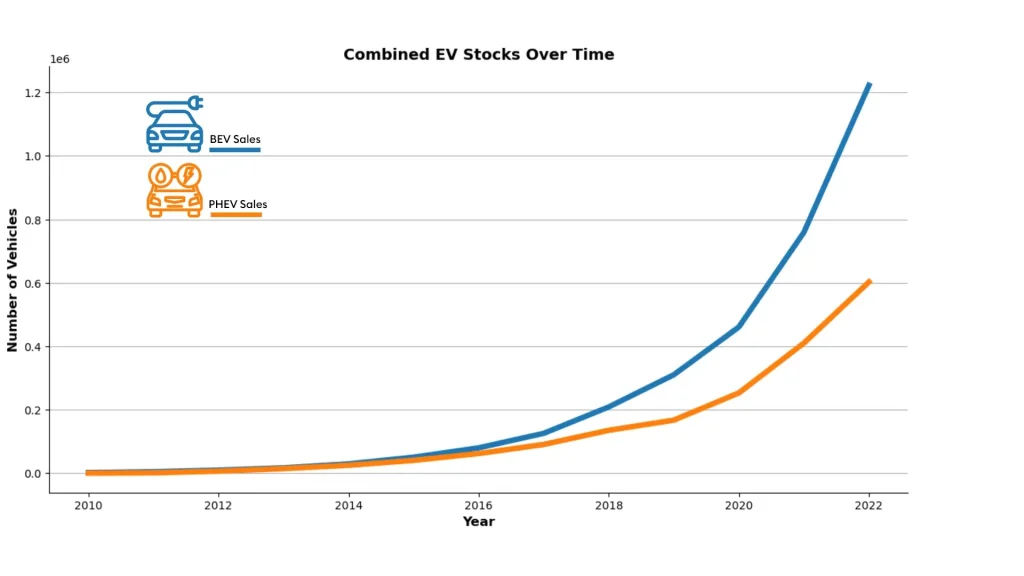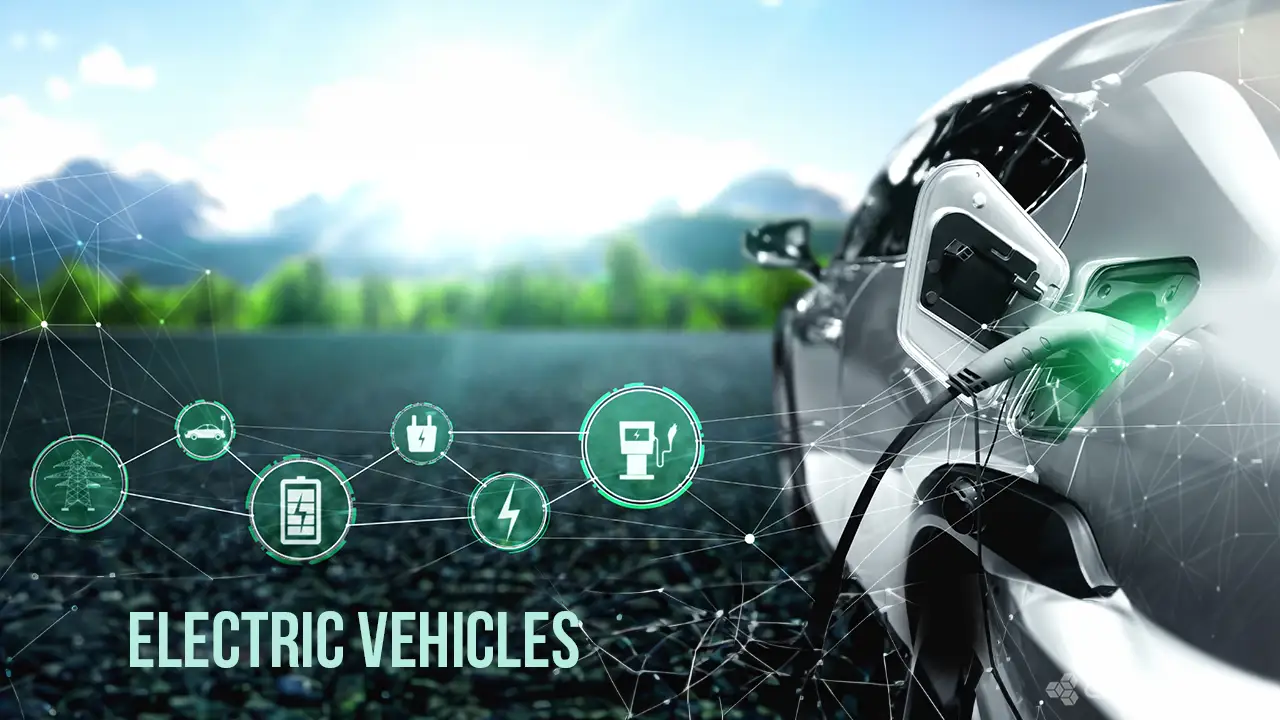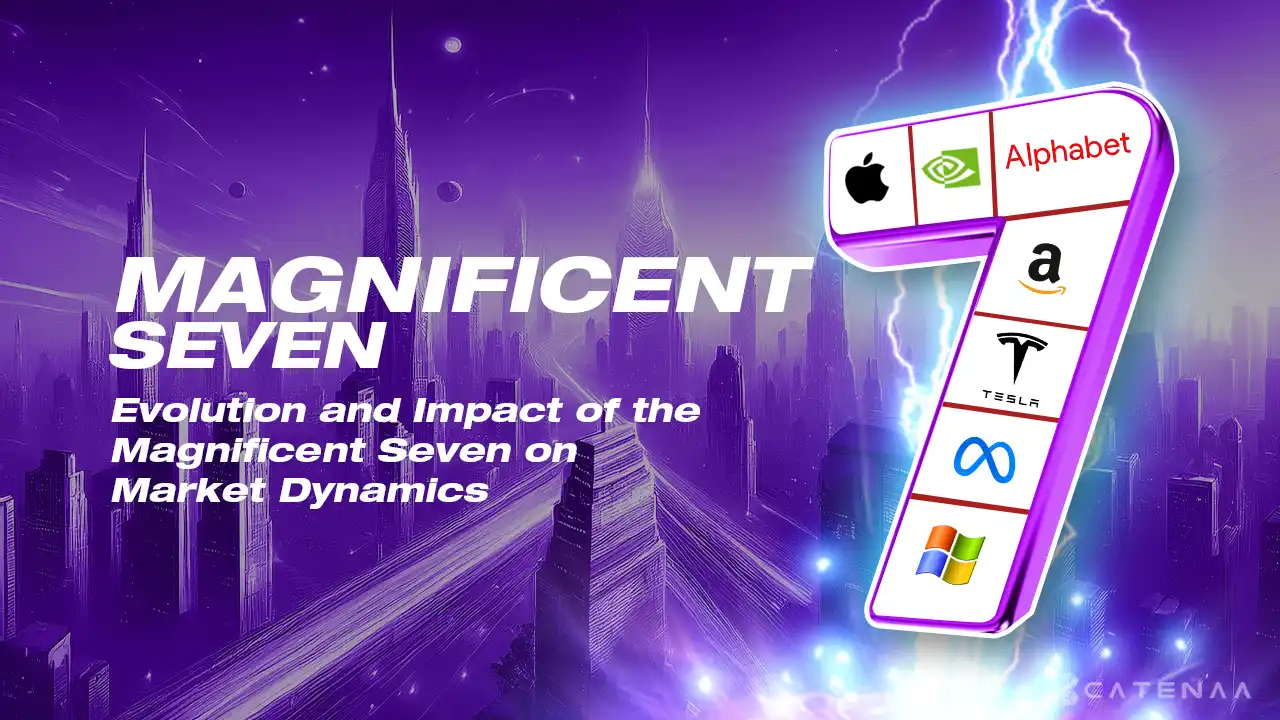Table of Content
The United States and the United Kingdom, prominent players in the global electric vehicle (EV) arena, have experienced a rapid surge in the availability of EVs, as depicted below.

Notably, the growth rate of Battery Electric Vehicles (BEVs) has outpaced that of Plug-in Hybrid Electric Vehicles (PHEVs).


US Demand for Electric Vehicles Falls Short of Industry Expectations

Consumer appetite for battery-powered cars and trucks has fallen short of industry expectations. As a result, the US automotive sector is delaying plans to increase the production of electric vehicles (EVs).
Due to “slowing near-term growth,” US automaker General Motors said in October that it will no longer be producing 400,000 EVs by the middle of the next year. 1 Due to a “flatter growth curve that we’re seeing relative to what the industry expected and we expected,” Ford announced that it was delaying its $12 billion in EV investments. According to data from Cox Automotive, the Biden administration wants 50% of all new vehicle sales to be electric by 2030, up from fewer than 8% of cars sold in the third quarter. 2
Instead of starting production of electrified Chevrolet Silverado and GMC Sierra pickup vehicles at a Michigan plant next year, GM has decided to postpone the project until 2025. Despite the impressive savings by switching from Gas to Electric, Ford is now holding off on investing roughly $12 billion to expand its electric vehicle production capacity after the company reported a $1.3 billion loss in its EV segment during the third quarter. This entails suspending work on one of the two joint-venture battery plants scheduled to be built in Kentucky and reducing some Mustang Mach-E manufacturing. Ford has set a goal of 600,000 EVs sold in 2024, while GM intends to sell one million EVs annually by the end of 2025. Originally an electric vehicle manufacturer, Tesla has stated that it hopes to sell 20 million cars annually by 2030 a more than tenfold increase in production. Elon Musk, the CEO of Tesla, stated that his company was analyzing the macroeconomic environment “before we go full tilt” to establish a plant in Mexico. 3

According to data group Cox Automotive, a record 313,000 electric vehicles were sold in the US during the third quarter. The percentage of industry sales that were electric vehicles increased to 7.9% in the third quarter from 6.1% the previous year. Still, the rate of increase is declining. According to Cox Automotive’s research firm Kelley Blue Book, sales growth for the third quarters of 2021 and 2022 was over 75% year over year; this year, the increase was a relatively mild 50%.
Additionally, EVs remain on dealership lots for longer. Compared to October 2022, dealers are taking 88 days to sell their full inventory of electrified vehicles and trucks, up from 39 days. A Yahoo Finance/Ipsos survey indicates that only one-third of US customers believe they will likely purchase an electric vehicle for their next car or truck. 4 The infrastructure for charging EVs, their driving range, and their cost concerning combustion-engine vehicles were the most typically voiced concerns.
According to Steve Brown, a rating analyst at Fitch, “It feels like the early adopters have adopted. At this point, it needs to reach a wider audience, and it appears that mainstream consumers are more hesitant for a variety of reasons.” Pricing is a crucial component. The Inflation Reduction Act of the Joe Biden administration, which aimed to increase domestic EV production, has limited the number of EVs that qualify for a $7,500 tax credit to models that fulfill certain requirements. The models that meet requirements for US assembly and component sourcing are the only ones eligible for a $7,500 tax credit under the Joe Biden administration’s Inflation Reduction Act, which aimed to boost domestic EV production. The credit is intended to lower the cost of the EVs, and starting next year, purchasers will be able to claim it at the time of sale rather than having to wait to file their taxes.
Historically, EVs have been more costly than traditionally powered vehicles; nevertheless, Kelley Blue Book claims that Tesla’s early-year pricing reductions “moved the market.” Last month, the average price paid for a new car was almost $47,900. The average price of an EV was $50,700, which was down 22% from a year earlier. However, Musk said that because high interest rates increased customer’s monthly car payments, they were reducing demand for the company’s vehicles. In the third quarter, the business delivered fewer cars than Wall Street anticipated. GM CEO Mary Barra stated that the business would be able to sustain strong pricing by “moderating the pace of our EV acceleration.” However, Ford executives stated that they anticipated a decline in the premium that EVs commanded. According to Lawler, there is currently “tremendous” pricing pressure on electric cars, and “going forward, it’s a cost game in EVs.” 3
In conclusion, investors can expect the EV industry in the US to expand but at a slower-than-anticipated pace. The demand for EVs is still good, but the supply is better: a problem that could potentially be resolved by the US automotive sector delaying plans to increase production of EVs.
Rising Insurance Costs for Electric Vehicles in the UK Hinder Widespread Adoption
The surging insurance costs in the UK for EVs could jeopardize their widespread adoption. In contrast with fossil fuel cars, auto insurers have increased the cost of coverage for electric vehicles (EV) significantly over the past year. Because it’s hard to underwrite the cost of replacing or repairing battery-powered automobiles’ components a problem made worse by a lack of skilled personnel some providers are reluctant to give coverage for these vehicles. 5
In fact, at the request of French underwriter Covéa, John Lewis has halted sales of its electric vehicle coverage while it revaluates the cost of repairs. 6The average cost of insurance for electric cars increased by 72% in the year ending in September as opposed to 29% for models powered by petrol and diesel. In a market where wider inflationary pressures have raised the price of motor insurance for all vehicles to an all-time high, these variables have presented additional hurdles for insurers. The appeal of electric cars and vans for businesses and motorists is threatened by rising insurance costs, according to Ben Nelmes, chief executive of New Automotive, a non-profit organization that promotes the switch to electric vehicles. 7 This is because rising insurance costs undercut one of the main benefits of electric vehicles, which is their lower running costs. The average cost of insurance for the Tesla Model 3, the most quoted electric vehicle on Confused.com, a price comparison site, increased by more than two-thirds over the past two years. 8 Indeed, a few months after withdrawing insurance for certain Tesla cars earlier this year, Aviva reintroduced coverage. 9 According to Thatcham Research, EV claims are often 25% higher than combustion equivalents and need 14% more time for repairs. 10 High replacement expenses are to blame. It can be challenging to get specialized personnel and spare components. The fact that EVs are still relatively new and insurers lack sufficient historical data on their maintenance does not help either.
Batteries have their own set of issues. These are pricey accessories that account for around half of the total cost of the car. For models with longer ranges and higher power, that might be more. They are also vulnerable to small harm. That can raise safety issues because even tiny scratches on battery packs have the potential to destabilize the cells, which might result in fires or even explosions. Many EVs are simply being written off for damage that conventional vehicles would withstand due to a combination of high costs and unpredictable outcomes. Because their lower ongoing costs more than makeup for their higher initial cost, EVs are about to become economically competitive with internal combustion engines. Adoption rates will change as increasing insurance costs make EVs less appealing.
Prospective buyers’ concerns about the greater cost of electric cars (EVs) and their lack of charging infrastructure will be worsened by the rising cost of insurance. The percentage of people who can afford insurance narrows if there is a significant increase in cost. Finding enough insurer capacity to cover EVs was an issue, with underwriters noting challenges locating spare parts and skilled workers as adding to unsustainable prices. All these factors are making some insurers reconsider their appetite, but not all of them. When UK automakers must double EV sales in January 2024 to achieve mandated targets, it will be a crucial early test of the insurance appetite.
The market may have adequate coverage in the long run if major insurers like Aviva commit to insuring EVs as part of their green transition strategy. Mike Powell, a vehicle insurance specialist at Defaqto, a company that evaluates and analyses financial goods, stated that although some insurers are pickier than others, they will still insure electric cars. 11 Insurers were “struggling with electric cars” for a variety of reasons, one of which being a technician shortage, which analysts expect would only become worse as more EVs become widely used.
Whether EV owners should worry about the increased insurance costs in the UK depends on is this is a fleeting occurrence. In the short term, Investors can expect the surging insurance costs to jeopardize the widespread adoption of EVs, because it’s hard to underwrite the cost of replacing or repairing battery-powered automobiles’ components a problem made worse by a lack of skilled personnel.
In summary, the examination of the EV sector in the US and the UK reveals complex issues and patterns influencing the direction of the market. Although the availability of EVs has increased, outpacing the rise of traditional cars with internal combustion engines, industry forecasts for demand have not been fulfilled. A slower-than-expected rate of industry expansion has been observed in the US, as major automakers have delayed planned production expansions due to worries about consumer hunger, infrastructure, and pricing dynamics. Similar to this, in the UK, rising insurance costs represent a major obstacle to the broad adoption of EVs. These costs are exacerbated by the difficulty in underwriting and repairing EV components, as well as a shortage of trained people and replacement parts. These difficulties pose a danger to EVs’ appeal and ability to compete economically, which could affect how widely they are adopted.

Looking beyond these two significant markets, it is clear that similar dynamics might be at work everywhere. For example, Australia exhibits a similar pattern of EV supply exceeding demand. Consequently, a thorough comprehension of the obstacles and prospects confronting the electric vehicle industry demands considering a variety of market conditions and dynamics. To fully realize the potential benefits of sustainable transportation, stakeholders from a variety of industries and geographical areas will need to work together to address these issues and create an environment that is conducive to the adoption of EVs.
Graphs and Data Attribution
EV Charging Points in the UK Over Time & EV Charging Points in the USA Over Time
- IEA.org. (n.d.). Global EV Data Explorer: EV charging points data differentiated by country. Retrieved from Global EV Data Explorer
Combined EV Stocks Over Time & EV Sales Over Time (USA)
- IEA.org. (n.d.). Global EV Data Explorer: EV stocks and sales data over time differentiated by country. Retrieved from Global EV Data Explorer
Comparison of Gasoline and Electric Vehicle Costs by Manufacturer
- Insurify.com. (n.d.). Electric car trends and statistics: Vehicle cost comparisons by manufacturer. Retrieved from Insurify.
Comparison of Car Model Statistics
- Insurify.com. (n.d.). Electric car trends and statistics: Car model statistics comparison. Retrieved from Insurify.
- Electric Vehicle: https://www.thestreet.com/electric-vehicles/major-automaker-makes-a-surprising-move-with-its-electric-vehicles[↩]
- Electric Vehicle: https://www.coxautoinc.com/news/new-cox-automotive-study-ev-consideration-at-record-high-but-dealers-feel-unprepared/[↩]
- Electric Vehicle: https://www.ft.com/content/80d79220-612f-4c01-93b7-1d1a846e4b6d[↩][↩]
- Electric Vehicle: https://finance.yahoo.com/news/new-yahoo-finance-ipsos-poll-shows-over-half-of-americans-unlikely-to-buy-an-ev-130040140.html[↩]
- Electric Vehicle: https://www.ft.com/content/0b4e4deb-10ec-4127-a563-f7791ad16527[↩]
- Electric Vehicle: https://www.insurancetimes.co.uk/news/john-lewis-pauses-offering-ev-cover-after-underwriter-decision/1445752.article[↩]
- Electric Vehicle: https://newautomotive.org/press-statements[↩]
- Electric Vehicle: https://www.confused.com/car-insurance/electric-car-insurance[↩]
- Electric Vehicle: https://www.theguardian.com/money/2023/sep/30/the-quotes-were-5000-or-more-electric-vehicle-owners-face-soaring-insurance-costs[↩]
- Electric Vehicle: https://www.thatcham.org/wp-content/uploads/2023/07/Impact-of-BEV-Adoption-on-the-Repair-and-Insurance-Sectors-report-Innovate-UK-and-Thatcham-Research-FINAL.pdf[↩]
- Electric Vehicle: https://www.thetimes.co.uk/article/car-insurance-customers-warned-over-extra-set-up-fees-9bzsfwf7w[↩]


